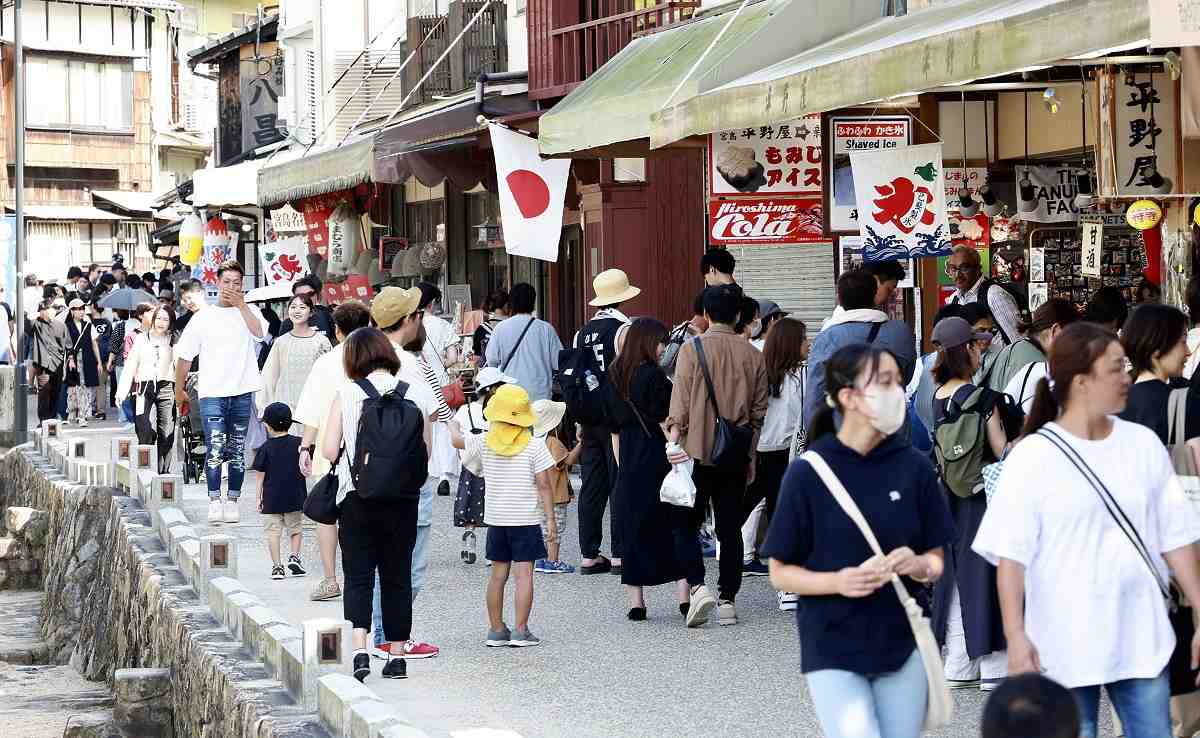
The island of Miyajima in Hatsukaichi, Hiroshima Prefecture, is crowded with tourists on Sept. 23.
16:36 JST, October 7, 2023
HATSUKAICHI, Hiroshima Pref. — A growing number of municipalities are considering the introduction of “tourist taxes” in response to overtourism.
A tourist tax of ¥100 was introduced Oct. 1 for the island of Miyajima, which is part of Hatsukaichi, Hiroshima Prefecture, and home to Itsukushima Shrine, a UNESCO World Heritage site. The Miyajima tax is applied to tourists of elementary school age or older, while residents of the island and students on school excursions are exempt.
The tax is imposed by adding ¥100 to the round-trip fare for ferry rides to and from the island. A ¥500 annual payment can be made as well.
The Hatsukaichi municipal government expects the new tax to generate ¥250 million in annual tax revenue, which will be used for such purposes as handling the growing amount of waste and building more public restrooms, which are currently in short supply.
On Oct. 1, about 20 officials of the Hatsukaichi municipal government handed out leaflets to tourists and others at the Miyajimaguchi Ferry Boarding Area on the opposite shore of Miyajima, to let tourists know about the visitor tax.
“If the tax revenue is used to improve restrooms and other facilities, that will benefit tourists, too,” said a 43-year-old male company employee of Aki Ward, Hiroshima. “I think it’s alright, if the point is to protect the famous sightseeing spot of Miyajima.”
A 30-year-old female company employee visiting the island from Kanonji, Kagawa Prefecture, said: “¥100 is acceptable. I hope the tax revenue is used to maintain the beautiful landscape of Miyajima.”
In 2019 before the COVID-19 pandemic began, a record high of 4.65 million people visited the island, which has a residential population of about 1,400. The Group of Seven summit was held in Hiroshima in May, so more and more foreign tourists have visited Miyajima. The number of visitors to the island is likely to hit a new record this year.
But even if there are more tourists, the tax grants from the central government to Hatsukaichi do not increase.
The city spends about ¥300 million a year improving tourist facilities on the island. Hatsukaichi Mayor Taro Matsumoto is seeking understanding for the new burden, saying, “We’ll make effective use of the new revenue to develop a sustainable tourism area.”
A visitor tax is not stipulated by law, but imposed by the relevant municipality based an ordinance. Introducing such a tax requires the approval of the internal affairs and communications minister.
Starting in 2005, four villages on remote islands in Okinawa Prefecture, including the villages of Izena and Tokashiki, began charging such taxes, adding ¥100 to the fares for ferries and other rides.
Residents of the four villages also pay the taxes. In the village of Izena, the tax generated ¥3.53 million in fiscal 2022. “The tax is necessary to protect the island, and residents and others are aware of that,” a village official said.
Some municipalities are considering introducing visitor taxes. The town of Taketomi in Okinawa Prefecture encompasses nine inhabited islands, including the World Natural Heritage site Iriomote, and is preparing to introduce a visitor tax to tackle overtourism, which could harm the local ecology.
Taketomi had about 1 million visitors a year before the pandemic and spends about ¥1 billion annually in such areas as developing tourism facilities. In fiscal 2019, it introduced a voluntary ¥300 entry fee for tourists visiting the town, but only about 10% of tourists actually paid the fee in fiscal 2022.
The town plans to introduce the tourist tax by the end of fiscal 2024, and it has been considering the amount of the tax.
The Sado municipal government in Niigata Prefecture, which aims to put the Sado gold mine site on the list of UNESCO World Cultural Heritage sites in 2024, is discussing the introduction of a visitor tax. The Amami municipal government in Kagoshima Prefecture has established a committee to discuss the issue, to protect the landscape and nature of Amami Oshima island, which is a World Natural Heritage site.
“It’s impossible for the residents of a small island to shoulder the entire burden of providing public services to the growing number of tourists,” said Masafumi Tsukamoto, a professor of public finance at Daito Bunka University. “If they introduce visitor taxes, it’s important to carefully explain how the tax will be used so visitors won’t feel like they’re being treated unfairly.”
"Society" POPULAR ARTICLE
-

M4.9 Earthquake Hits Tokyo, Neighboring Prefectures
-

Israeli Tourists Refused Accommodation at Hotel in Japan’s Nagano Pref., Prompting Protest by Israeli Embassy and Probe by Prefecture
-

M7.5 Earthquake Hits Northern Japan; Tsunami Waves Observed in Hokkaido, Aomori and Iwate Prefectures
-

Tsukiji Market Urges Tourists to Avoid Visiting in Year-End
-

High School in Kyoto Says Students Shoplifted during Recent School Trip to Bali, Indonesia
JN ACCESS RANKING
-

Tokyo Economic Security Forum to Hold Inaugural Meeting Amid Tense Global Environment
-

Keidanren Chairman Yoshinobu Tsutsui Visits Kashiwazaki-Kariwa Nuclear Power Plant; Inspects New Emergency Safety System
-

Imports of Rare Earths from China Facing Delays, May Be Caused by Deterioration of Japan-China Relations
-

University of Tokyo Professor Discusses Japanese Economic Security in Interview Ahead of Forum
-

Japan Pulls out of Vietnam Nuclear Project, Complicating Hanoi’s Power Plans

























